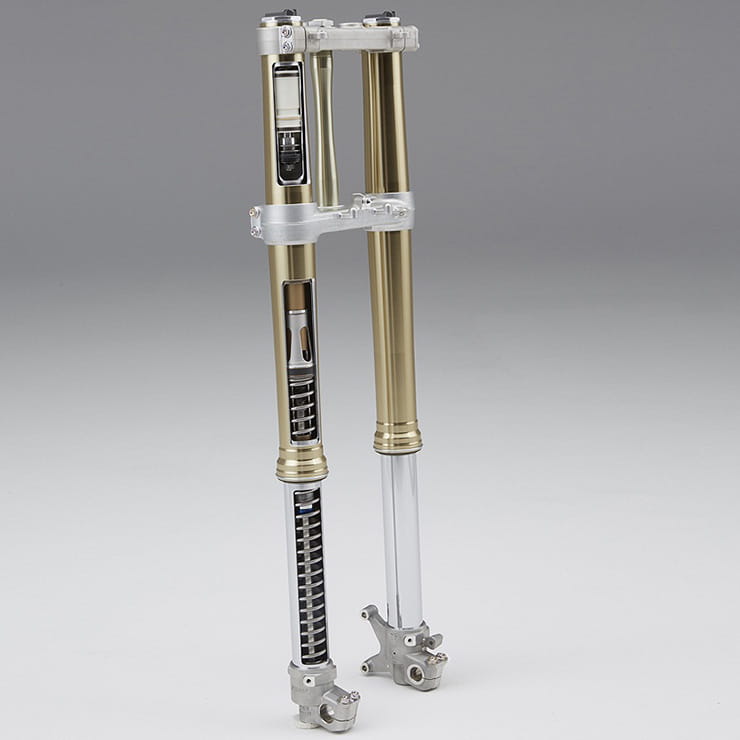Standard upsidedown cartridge fork. The sealed damper cartridge is below the spring
The new Gold Wing, numerous BMWs and a few rare groove bikes such as the Bimota Tesi don’t use telescopic forks, but it’s telling that everything else does, from loony motocross race bikes to Harley cruisers. Forks work brilliantly.
Why are forks so effective?
Partly because, in principle at least, they’re simple. There’s a spring in each fork tube to support the weight of the bike and allow the wheel to react to bumps, and a damping system to stop the bike bobbing up and down like a cork on stormy sea.
What kinds of springs are there?
The simplest and most common is as you’d imagine - a single regular steel coil. By changing the diameter of the wire and the number of turns you can alter the spring rate, which describes how much force is need to deflect the spring a given amount. So a spring rate of 10N/mm means it takes 10N of force to compress the spring by 1mm.
Then there are combinations of springs. So you might have a main spring that does most of the work, but when the forks compress a certain amount, they hit another shorter spring that joins in as well, making the forks stiffen up.
Progressive springs use variations in the windings to create the effect of multiple springs. As the spring compresses, the most densely packed windings eventually come together into a solid lump, effectively increasing the spring rate.
What difference does all this make?
Well if your springs are too soft for your weight or riding style, you might find the bike dives dramatically on the brakes or bottoms out (ie the springs compress so much that the coils hit each other and there’s no spring effect to be had). Conversely, if the springs are too hard, you’ll probably notice your wrists being pummelled over harsh bumps and the front tyre skipping over small ones. And that’s just the start – both scenarios mean the forks aren’t working over their full stroke, so the damping doesn’t have a chance to work properly either.
What’s preload?
As the name suggests, it’s how much load is on the spring when the forks are fully extended. Without it, you’d push the bike off its centrestand and the forks would sink down way too far, using up loads of the suspension stroke. Preloaded, they should drop about a quarter of the stroke if you’ve got your sag set correctly. Preload doesn’t alter the spring rate though - it just changes where the fork action takes place – you use it to adjust your ride height. You can only alter spring rate by changing the springs.
Replacement springs are the only way to change spring-rate unless you have very fancy electronic suspension
What’s damping?
This is done in two basic ways, either using a damper rod or a cartridge (we’ll choose to classify Big Piston forks as a clever subset of cartridge forks rather than a different system). Damper rods are the simplest, cheapest set-up, but also the crudest. As the forks compress, the damper rod piston forces oil through various holes, slowing (ie damping) the movement. When the forks rebound, oil flows through a different set of holes, again damping the movement - usually to a greater degree, because you want less compression damping than rebound (just hit a kerb to find out why). The problem with the damper rod system is as that as the forks move faster (hitting that kerb, for example), damping increases by the square of the speed. That’s the opposite of what you want – the forks effectively lock solid if you hit a kerb at speed.
This is a Showa Separate Function Fork from a KX250 motocrosser, with one side housing the spring and preload, while the other houses the damper.
So cartridges are better?
Yes, lots. They use a stack of different size shims to control oil flow within a cartridge. At low speeds the oil bends the weakest shim and leaks through a bit, gently controlling the movement. If you hit that kerb, the sudden jolt forces the oil to bend all the shims and you get a massive flow, letting the forks move up fast. Cartridge forks also have the advantage that they can have adjusters to control the damping on the compression (usually on the bottom of the fork leg) and rebound (on the top) strokes, and even vary the high and load speed damping rates. On forks with no adjustment, you can only vary damping rates by altering the viscosity of the oil, or the quantity.
And upside-down forks?
They’re as they sound - like normal forks but the other way up, with the thicker outer tube at the top. That’s an advantage when braking, because it’s stiffer.







